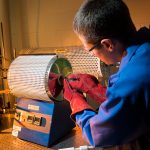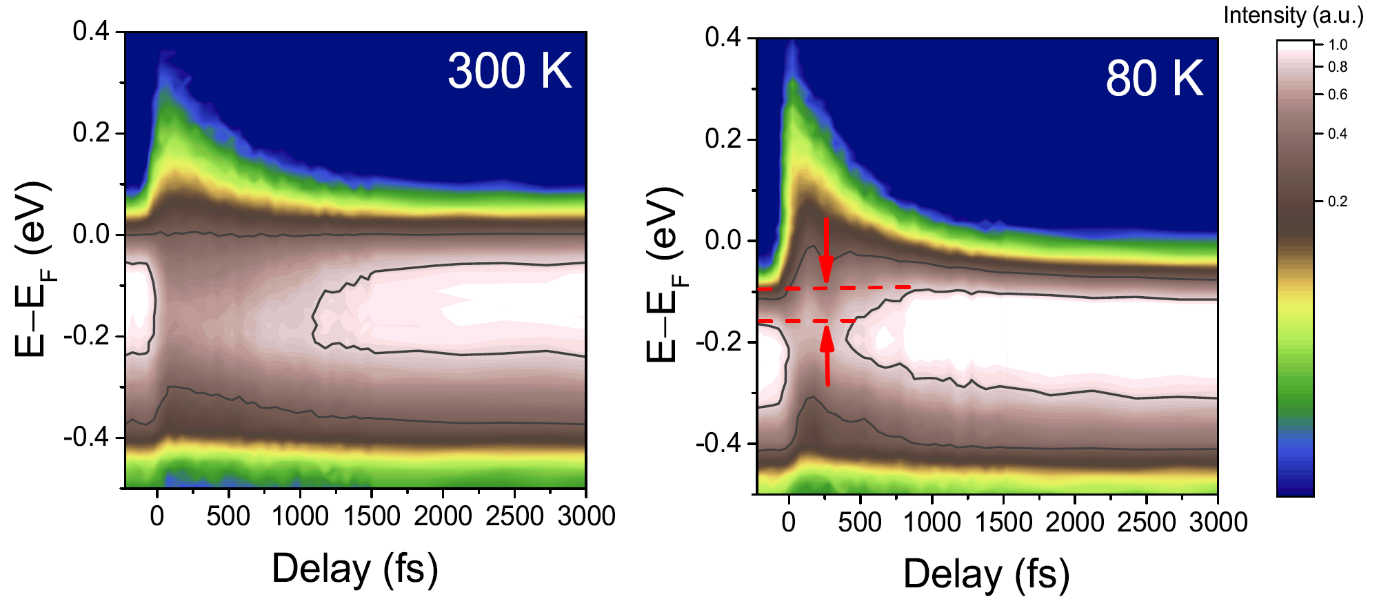Read more about what research our current students are doing.
Cohort 1
Lewis Hart – Novel transition metal dichalcogenide semiconductors and heterostructures
Supervisor – Dr. Daniel Wolverson
There is a family of crystalline materials that can be isolated to layers which are only a few atoms thick, the 2D materials. Lewis’s work concentrates on two of the more unusual members of this family, rhenium disulphide and rhenium diselenide. These crystals are semiconductors with in-plane optical and electronic anisotropy. Lewis’s PhD involves investigating this anisotropy using Raman spectroscopy and Angle Resolved Photoemission Spectroscopy (ARPES).
Figure below: (a) a slice of the bandstructure of ReSe2 and (b) electronic dispersions along 3 inequivalent directions measured using ARPES (image from Hart et al., Sci. Rep.7 5145 (2017))
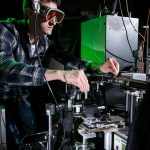

David Hooper – Nanoscale confinement of photons, electrons and magnetism in plasmonic metamaterial
Supervisor – Dr. Ventsislav Valev
Davids research involves using ultra-fast lasers to probe the nonlinear optical properties of nano/meta-materials. The surface electrons bound in metallic nanoparticles can be driven in collective oscillations, known as a localised surface plasmon resonances. These plasmon resonances dramatically increase the local electric field which in turn enhances nonlinear optical processes, such as second harmonic generation. Nanoparticle systems allow for a great flexibility in design as a variety of parameters can be tuned, such as particle material composition and geometry as well as the dimensions of nanoparticle arrays. David studies how these changes influence a systems nonlinear optical properties.
Rebecca Purkiss – Seeing is believing: single atom manipulation on graphene
Supervisor – Dr. Peter Sloan
Rebecca uses a Scanning Tunnelling Microscope (STM), to not only see atoms, but to manipulate them. By firing hot electrons into a silicon surface she can cause dosed toluene molecules to desorb (leave the surface) or diffuse. This tells us information about the energy levels and lifetimes of states in our system, and she is investigating whether there are ways to influence this manipulation outcome. Rebecca has also used the STM to investigate light output from the same system, and started some groundwork on a new system of oxygen atoms dosed on a graphite surface.
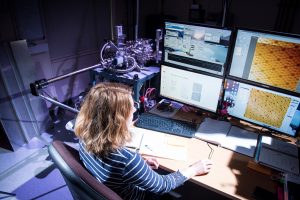
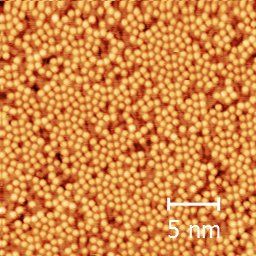
This is a 25nm image of the silicon surface dosed with toluene, taken at 1V. The bright atoms are silicon and the dark atoms are toluene molecules.
Joshua Robbins -The Kerr effect in high temperature superconductors
Supervisor – Prof. James Annett and Dr. Martin Gradhand
The Kerr effect is an optical phenomenon which arises in states in which time-reversal symmetry (TRS) has been broken. Joshua’s research focuses on the theoretical modelling of this effect in unconventional superconducting states. It is believed that superconducting states which have broken TRS may become vital tools in quantum computing applications, but our understanding of these states is currently insufficient. The work carried out here involves the development and implementation of tight-binding codes which perform the numerical computation of the anomalous Hall conductivity, which drives the Kerr effect. The goal is to improve our understanding of superconductivity in unconventional states.
Joseph Wilcox – Superconducting energy gap structure of Sr2RuO4
Supervisor – Prof. Anthony Carrington
In unconventional superconductors, the origin of the pairing mechanism still remains an open question, with a number of theories posited to explain superconductivity in the various unconventional families. The structure of the superconducting energy gap is intimately linked to the pairing mechanism. Joseph performs very low temperature measurements (~ 50 mK) of the magnetic penetration depth and lower critical field on a number of unconventional compounds. From these measurements it is possible to make some conclusions about the nature of the gap structure, helping to rule out theories that do not conform.
Cohort 2
Jake Ayres – High-pressure studies of high-temperature superconductors at high magnetic fields
Supervisor – Dr. Sven Friedemann and Prof. Antony Carrington
Even after 30 years, consensus on the origin of superconductivity in the cuprate family of high temperature superconductors has yet to be reached. Pressure offers a useful tuning parameter with which to study superconductivity and other associated phases without introducing disorder as is necessary with chemical doping. Jake performs electronic transport measurements at high magnetic fields and under high pressures in order to further understand the superconducting state in unconventional superconductors.
Nicola Bannister – Lattice vibrations of the new β-coronene
Supervisor – Dr. Simon Crampin and Dr. Enrico Da Como
Organic electronics is an exciting field of active research. Devices based on single crystal organic semiconductors are of particular interest as they allow intrinsic properties to be exploited. A requirement of this is good phase homogeneity and so understanding the polymorphism of organic molecular crystals is important. A new polymorph, the β phase, of the molecular crystal coronene, was recently synthesised by growth in a magnetic field in Bristol [J. Potticary et. al., Nat. Comm., 7(11555), (2016)]. This was an exciting discovery as it is the first time a new polymorph has been accessed by use of a magnetic field. The new β-phase was shown to have a lower lattice energy than the naturally occurring γ-phase by dispersion-corrected Density Functional Theory (DFT-D), presenting an intriguing puzzle to solve. Nicolas project aims to build on this previous work by investigating the vibrational properties and hence relative phase stabilities of both polymorphs using experimental methods, such as Raman spectroscopy, and computational methods, namely DFT-D. Furthermore the method and reliability of growth techniques for β-coronene is being investigated.
Dewan Chowdhury -Anisotropic transport in 2D material heterostructures and devices
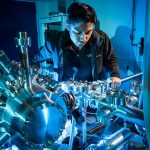
Supervisor – Dr. Adelina Ilie
Practical devices based on graphene are of great interest. Dewan aims to harness unique quantum properties of graphene that can lead to anisotropic transport and confinement of its charge carriers. Anisotropic transport would allow charge carriers to be guided in tailored directions, similar to how optical fibres guide light. Consequently, more versatile electronic devices can be possible.
Aitor Garcia Ruiz – Superconductivity-induced features in electronic Raman spectrum of two dimensional systems
Supervisor – Dr. Marcin Mucha-Kruczynski
How does the Raman spectrum of a superconducting two dimensional system look like? This question summarizes the PhD project of Aitor García-Ruiz at the Bath University, under the supervision of Marcin Mucha-Kruczynski. From a purely theoretical perspective, they model superconductivity in two dimensional materials and study the light-matter interaction in these systems to predict superconductivity-induced features in their Raman spectrum. So far, they have found an answer to this question for graphene, and this will be the topic of Aitor’s first publication.
Emma Gilroy – Uranium-based spintronics
Supervisor – Dr. Chris Bell and Dr. Ross Springell
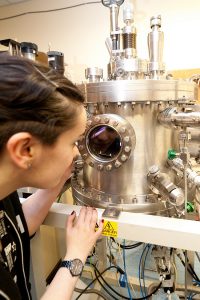
Emma’s research focuses mainly on magnetism and magnetic materials for possible applications in computer storage and reading of data. Ferromagnets allow technology to take advantage of a fundamental property of electrons known as spin: electrons act like microscopic bar magnets, with north pointing ‘up’ or ‘down’. In a ferromagnet, a majority of electrons are in one direction, giving a net magnetisation. Devices which utilise this spin degree of freedom are known as spintronic devices. These devices are often fabricated from magnetic materials (for example Co, Ni and Fe) and heavy metals, such as Au, Pd or Pt. For my PhD project, Emma is looking at the effect of replacing the Au, Pd or Pt in a device with the heaviest natural element. This element is uranium (U). Currently she is investigating precise thin bilayers of iron (Fe) and U, and studying the magnetic properties of the bilayers using magnetometry and electronic transport measurements.
Torsten Jensen – Synthesis of the first electrically excited organic lasers
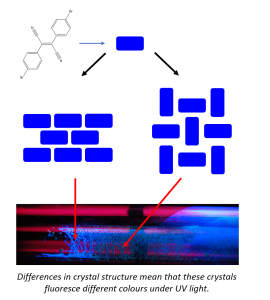
Supervisor – Dr. Simon Hall
Torstens research covers the growth and characterisation of organic molecular crystals for use in opto-electronic devices including LED’s, solar cells and lasers. Crystal structure, impurities and even morphology (texture) can have drastic effects on the conductive and optical properties of these systems. His work bridges the properties at the molecular level to the visible scale with the aim of making highly efficient organic devices.
Daniel Lagos – Probing electronic structure with synchrotron light
Supervisor – Prof. Stephen Dugdale
Elisha Mercado – Thermal, electrical and optical transport in 2D-heterojunctions
Supervisor – Prof. Martin Kuball & Dr. Julian Anaya
Lauren Cane – Spin and charge correlations in oxide metals
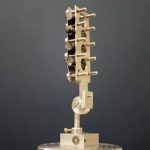
Supervisor – Prof. Stephen Hayden
Lauren uses neutron and x-ray scattering techniques to measure charge and spin-order in cuprate compounds with the aim of gaining better insight into the interplay with superconductivity. She grows her samples in Bristol and performs experiments at various international facilities.
Hannah Robarts – Probing magnetic excitations with synchrotron light
Supervisor – Prof. Stephen Dugdale and Prof. Stephen Hayden
Hannahs current research revolves around the experimental technique of resonant inelastic x-ray scattering (RIXS). RIXS uses synchrotron x-rays to measure small energy and momentum transfers in crystals. Tuning to the resonance of a chosen 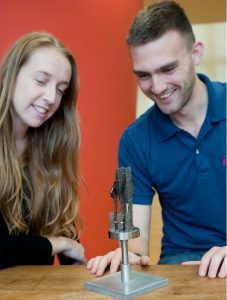 absorption edge allows specific excitations to be observed with high resolution. For the last four months she has mainly been working at Diamond Light Source, where the new RIXS beam line, I21, is just coming online. She was lucky enough to take part in the first experiment at I21 where we focused on the magnetic excitations in the cuprate superconductor parent compound La2CuO4. Hannah hopes that their work will contribute to the understanding of how changing magnetic interactions across the cuprate phase diagram influence the pairing mechanism which underlies high temperature superconductivity. Future experiments are likely to involve continued use of RIXS to study charge and magnetic order in similar systems such as different cuprates and iron pnictides.
absorption edge allows specific excitations to be observed with high resolution. For the last four months she has mainly been working at Diamond Light Source, where the new RIXS beam line, I21, is just coming online. She was lucky enough to take part in the first experiment at I21 where we focused on the magnetic excitations in the cuprate superconductor parent compound La2CuO4. Hannah hopes that their work will contribute to the understanding of how changing magnetic interactions across the cuprate phase diagram influence the pairing mechanism which underlies high temperature superconductivity. Future experiments are likely to involve continued use of RIXS to study charge and magnetic order in similar systems such as different cuprates and iron pnictides.
Charles Sayers – Optical probes of charge density waves in 2D materials
Supervisor – Dr. Enrico Da Como
Charles’ research focusses on the layered transition metal dichalcogenides (TMDs) which exhibit a complex state of matter known as charge density waves (CDWs). He uses a combination of time-resolved spectroscopy and angle-resolved photoemission spectroscopy (ARPES) to investigate changes in the electronic structure of these materials due to the CDW phase transition. For these measurements, he grows single crystal TMDs and prepare van der Waals heterostructures of few-layer flakes.
Richard Waite – ISIS Project
Supervisor – Prof. Stephen Hayden
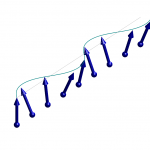 Richard uses neutron scattering techniques to study nematic spin fluctuations and order (that break the rotational symmetry of the lattice) at low temperatures in strongly correlated systems. The project is a collaboration with the ISIS neutron spallation source at Harwell, UK, with the aim of developing a device to apply uniaxial strain to samples during neutron scattering experiments. He recently took part in an experiment on the LET spectrometer at ISIS looking for low-energy ferromagnetic spin-fluctuations that could be responsible for unconventional superconductivity in Sr2RuO4. Future experiments will focus on nematic spin fluctuations and order when the lattice symmetry is broken by uniaxial strain.
Richard uses neutron scattering techniques to study nematic spin fluctuations and order (that break the rotational symmetry of the lattice) at low temperatures in strongly correlated systems. The project is a collaboration with the ISIS neutron spallation source at Harwell, UK, with the aim of developing a device to apply uniaxial strain to samples during neutron scattering experiments. He recently took part in an experiment on the LET spectrometer at ISIS looking for low-energy ferromagnetic spin-fluctuations that could be responsible for unconventional superconductivity in Sr2RuO4. Future experiments will focus on nematic spin fluctuations and order when the lattice symmetry is broken by uniaxial strain.
Cohort 3
Paolo Abrami – Superconducting gap structure and normal state properties of high temperature superconductors
Supervisor – Antony Carrington
Paolo is working in the CES group under the supervision of Dr. A. Carrington. His research revolves around the investigation of cuprates fundamental properties using specific heat measurements in magnetic field. Currently Paolo is working on YBCO 124. He is studying the role that the CuO chains play in the superconductivity of the material, specifically the anisotropy in the heat capacity given by the chains via the Volovik effect. Other studies include the investigation of YBCO quantum criticality and transport measurements in high magnetic field facilities.
Mara Bruma – High pressure studies of quantum criticality in unconventional superconductors
Supervisor – Antony Carrington
Achieving superconductivity at room temperature would open a new era of technological advances, if only we we understood what makes it tick. Under the supervision of Professor Antony Carrington, Mara will investigate one of the likely causes of high TCsuperconductivity, quantum criticality. Mara’s research focuses on measurements of superconducting magnetic penetration depth. The novel aspect is that we will tune the state of the material using high pressure – thus giving much better control of the material parameters than is achievable by chemical doping alone. This should allow us to precisely answer the question as to how quantum criticality influence the emergence of the superconducting state.
Liam Farrar – Gate-tuneable superconductivity and Fermi surface topology in few-layer FeSe
Supervisor – Simon Bending
The discovery in 2008 of superconductivity near ~8K in bulk iron selenide (FeSe) was an important scientific landmark because this is a stoichiometric superconductor with a simple crystal structure. It was soon discovered that the superconductivity in FeSe is remarkably tuneable, with Tc shown to increase up to 40 K under pressure or by intercalation. Liam’s work involves fabricating FeSe flakes in an electric-double-layer transistor configuration with various ionic liquids. By applying a voltage through the ionic liquid, the tuneable nature of superconductivity (Tc ~48 K) in this material can be explored. This experimental work is then complemented by density functional theory (DFT) calculations.
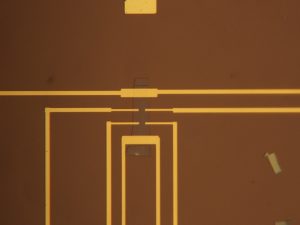
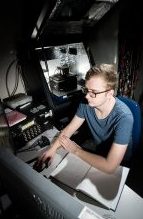
Lawrence Gammond – Project studentship (Hot Science) STFC/Diamond Light source
Supervisor – Phil Salmon
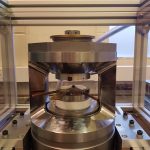
The Paris-Edinburgh press at the University of Bath
The effects of high pressure and high temperature on a material’s physico-chemical properties is of technological and geophysical importance. To understand the properties of a material, and how those properties change under the extreme conditions ofhigh pressure and high temperature, it is necessary to obtain information on the atomic structure. Neutron diffraction can be used to access this information, however, existing high pressure-high temperature instrumentation is limited by its irreproducibility and significant level of background scattering. It is, therefore, our aim to develop an easy-to-use internal heating system for the Paris-Edinburgh press, which will enable the structure of materials to be measured at pressures up to 20 GPa and temperatures up to 2000 K.
Surani Gunasekera – Electronic and structural phase engineering in layered transition metal dichalcogenides
Supervisor – Marcin Mucha-Kruczynski
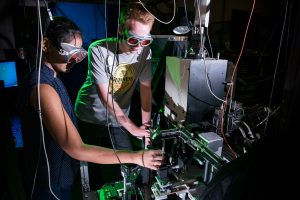 Layered transition metal dichalcogenides (LTMDs) are a group of materials which can be exfoliated down to single layers, similarly to graphene. Within the single layer, most of these LTMDs fall into one of (roughly) two arrangements of the chalcogen atoms surrounding the transition metal site. However, they cover a very broad range of physical properties: for example, some LTMDs are semiconducting, some are metals that can superconduct at low temperatures. In Surani’s research, she investigates theoretically the possibility of engineering or tuning LTMDs between their structural phases using external factors like pressure, electrostatic doping or intense laser light. Such phase switching, if feasible, would be of great interest for optoelectronic, spintronic or energy applications.
Layered transition metal dichalcogenides (LTMDs) are a group of materials which can be exfoliated down to single layers, similarly to graphene. Within the single layer, most of these LTMDs fall into one of (roughly) two arrangements of the chalcogen atoms surrounding the transition metal site. However, they cover a very broad range of physical properties: for example, some LTMDs are semiconducting, some are metals that can superconduct at low temperatures. In Surani’s research, she investigates theoretically the possibility of engineering or tuning LTMDs between their structural phases using external factors like pressure, electrostatic doping or intense laser light. Such phase switching, if feasible, would be of great interest for optoelectronic, spintronic or energy applications.
Charlie Hall – The role of magnetic fields in organic crystal growth
Supervisor – Simon Hall
The field of pharmaceutical crystallisation is dominated by the need to produce new crystal structures (polymorphs) which possess enhanced properties over current experimentally available structures. It has recently been shown in our research group that the use of applied magnetic fields during the growth of organic crystals can have effects on both crystal shape (morphology) and internal structure (polymorph). Charlies current research involves delving into to the possible causes of the observed changes, to allow a predictive method to produce new crystals due to this unforeseen effect. To achieve this goal, Charlie is using the new magnet lab in the School of Chemistry in Bristol to grow pharmaceuticals in homogeneous fields up to 3T. To compliment this work, in collaboration with UCL, he is also running surface energy simulations to help predict both the thermodynamic and kinetic contributions to the crystal growth.
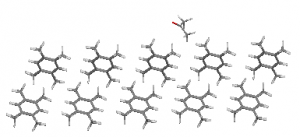
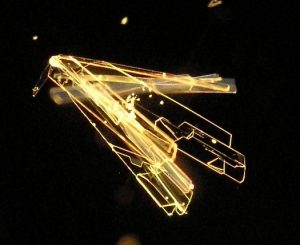
Alyn James – Strongly correlated electronic structure beyond the LDA
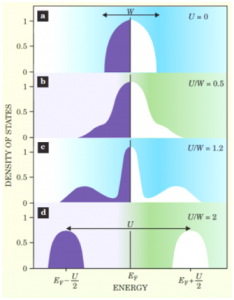
Supervisor – Stephen Dugdale
Alyns research is focused on improving our theoretical understanding of the electronic structure of correlated materials by combining dynamic mean field theory (DMFT) [1] with current practical implementations of density functional theory (DFT) [2]. He aims to use this technique (often referred to as DFT+DMFT) to investigate the impact of correlations in electron momentum distributions and compare these to experimentally measured Compton profiles. An example of the effect of correlations can be seen in figure 1. Here, as the intra-orbital interaction (U) increases for constant non-interacting band width (W), the electron-electron correlations influence the electronic structure. Figure 1 shows the case for a non-interacting system (a), weakly correlated system (a Fermi liquid) (b), a strongly correlated system (c) and a Mott insulator (d).
Nathan Missault – A magnetic tunnel junction for molecular spintronics applications
Supervisor – Walther Schwarzacher
For Nathans research he will fabricate and pattern trilayers consisting of two metallic layers separated by a dielectric of only a few nanometres thick. Such metal-insulator-metal tunnel junctions (MTJ) provide a robust platform to study charge and spin transport in organic semiconductors by bridging the tunnel barrier with molecules of interest. Organic spin-valves, where the metals in the MTJ are ferromagnetic, show considerable promise due to their long spin lifetimes and the low cost of room-temperature solution-based processing. In addition, a variety of organic semiconductors have been reported to exhibit extremely high intrinsic magnetoresistance. The MTJ allows us to study both this organic magnetoresistance and organic spin valves, while maintaining the ability to gate the molecules electrochemically. In the first stage Nathan will study the transport and magnetotransport properties of highly conducting conjugated polymers such as polypyrrole linking both ferromagnetic and non-ferromagnetic thin films, and will later move on to other interesting compounds such as functionalized DNA.
Owen Moulding – High-Pressure studies of hydrogen compound superconductors
Supervisor – Sven Freidemann
Owens research involves applying pressure, of the order of GPa, to superconducting compounds using gemstone anvil cells and measuring the resistivity, Hall effect, and magnetic susceptibility. Currently, the compounds he is studying are hydrogen sulphide and niobium diselenide; hydrogen sulphide is a recently discovered (2016) high-temperature superconductor with a critical temperature of 203K at 150GPa and it is believed to be a conventional superconductor. Further experimental understanding of why hydrogen sulphide superconducts at such a high temperature will hopefully provide insight into creating new high-temperature superconductors. Niobium diselenide superconducts at 7K but transitions to a charge density wave state at 26K. The goal is to investigate if these phenomena are related and if so, understand the underlying mechanisms.
Tom Saunderson – Spin-dependent transport in superconductors tailored by impurities
Supervisor – Martin Gradhand
Toms PhD project is focussed on implementing a solver for the superconducting state into a density functional theory code, accounting for the full normal state band structure but treating the superconducting interaction as a parameter. The aim is to use this code to perform spin transport calculations for superconducting materials with a particular focus on the effect of impurities and interfaces. This will provide insight into the coupling between superconductivity and magnetism influenced by impurities and ultimately the spin-orbit coupling.
Cohort 4
Robert Armstrong – Nanostructured Nitride Materials for optoelectronic devices
Supervisors – Dr. Philip Shields and Dr. Daniel Wolverson
III-Nitride devices are highly desirable for optoelectronics due to there direct band gaps and large range in band gap size. This leads to many applications in LED’s amongst other devices.
Roberts project involves GaN quantum dot structures, with the eventual aim for the growth of site controlled GaN quantum dot’s on AlN nanorods. The use of these structures could be applied to optical and quantum computing for the generation of a site-controlled single photon source in the latter, leading to the generation of qubits. In his project Robert will be undertaking MOVPE growth, nanofabrication and characterisation.
Will Campbell – Developing the process for in situ fabrication of large area 2D material heterostructures to realise new optical and electronic devices
Supervisor – Prof. Simon Bending
This project will involve the development of the process for in-situ fabrication of large area 2D material heterostructures to realise optical and electronic devices. The choice of 2D material system can be either hBN/WSe2/hBN or 2D MoS2/WSe2 pn junctions (or similar functional combinations including graphene and conventional 3D dielectric layers). The aims of this project would be to characterize the optical and electronic properties of such stacks and investigate the interfaces between these layers through the fabrication of Field Effect Transistors.
Chloe Clear – Characterising phonon interactions in single molecules for non-classical light sources
Supervisors – Dr. Dara McCutcheon and Prof. Ruth Oulton
Single organic molecules constitute a novel and exciting platform to explore the quantum optics of isolated few-level systems. Moreover, their properties offer an attractive degree of tunability, which leads to the possibility of tailored and highly desirable non-classical light sources. as with all solid-state emitters, it is essential that coupling to phonons and the behaviour with temperature is properly understood, as this then allows for the development of strategies to combat dephasing effects. Chloe’s research involves performing calculations which characterise the influence of phonon coupling on the optical properties of these single organic molecules, with the aim of designing optical structures which will enhance the efficiency and purity of photon emission.
Sean Harding – Developing Tensor Network approaches to Dynamical Mean Field Theory
Supervisors – Dr. Stephen Clark
Strong correlations between the charge, spin and orbital degrees of freedom of electrons in a solid can result in novel phases of matter. Many of these phases cannot be understood quantitatively – or sometimes even qualitatively – with single-particle effective theories like Density Functional or Fermi Liquid theory, and require an explicit nonperturbative treatment of many-body effects.
Joseph Hitchen – Nanotectonics in the Synthesis of Light Element Superconductors
Supervisor – Dr. Simon Hall
Joseph’s project is split both between Chemistry and Physics where he concentrates on the growths and characterisation of organic crystals under magnetic fields, and the applicability of driving such crystals into superconducting modes by fabricating field effect transistors with organic crystals and thin films as active layers.
Taylor Moule – Gallium Oxide – The Next Generation of Microwave Devices
Supervisor – Prof. Martin Kuball
Today Silicon is ubiquitous in the semiconductor electronics industry – underpinning an array of modern technologies as diverse as satellite communications, digital imaging and computing. However, the fundamental limits of Silicon device performance are being approached in areas such as high-power and high-frequency RF electronics. Gallium Oxide, (β-Ga2O3), with its wide bandgap, (4.8eV), is a new and promising material for overcoming Silicon’s limitations.
However, the fabrication of Gallium Oxide devices is still in its infancy and much of the underlying physics of the material is poorly understood, including the reasons for its surprising low thermal conductivity and electron mobility. Our aim is to use optical, thermal and electrical characterisation techniques to gain a detailed understanding of Gallium Oxide and the performance of Gallium Oxide based transistors. These measurements will be complimented with device simulations.
Lukas Ohnoutek – Confinement of photons, electrons and magnetism in nano/meta-materials
Supervisors –Dr. Ventsislav Valev and Prof. Simon Bending
Lukas’ project focuses on the effects of confinement of photons, electrons and magnetism in nanomaterials. More specifically, we are going to study the properties of plasmonic nanostructures, including magnetic ones, using optical spectroscopy and explore how these properties can be controlled by tuning the shape of the nanostructures.
Israel Osmond – High-Temperature Superconductivity in Hydrogen Compounds
Supervisors – Dr. Sven Friedemann and Prof. Antony Carrington
After the record breaking discovery of high temperature superconductivity in hydrogen sulphide at 203K, a wave of research into hydride based superconductors has emerged. With many of these compounds requiring pressures up above 100GPa to meallise, Israel’s research focuses on developing high-pressure piston and diamond anvil cells compatible with commonly used SQUID magnetometers. Via the magnetic signature of the Meissner and mixed states, the goal is to detect and characterise the superconductivity in this new family of hydride superconductors.
Simon Payne – Organic superconductors in 3D
Supervisor – Dr. Simon Hall
Simons research group has recently discovered an entirely new way to control the growth of crystal polymorphs, by using strong magnetic fields to arrange pre-nucleation groups of molecules at the nanoscale. In Simons project he aims to apply this novel method of growth to alter the properties of organically based superconducting materials.
Alexander Petsch – Spin Excitations in transition metal oxides
Supervisor – Prof. Stephen Hayden
Alexander’s research is focused on magnetic and electrical excitations such as magnon, phonons and charge density waves in transition metal oxides such as the cuprate family of high temperatire superconductors and similar compound such as nickelates. Alexander is using netron and X-ray scattering techniques as different facilities around Europe and in-house facilities such to characterise these. Along with experimental work also theoretical techniques are explored such as different models to describe data or handle instrumentations and simulations. Also, Alexander makes use of in-house collaborations, currently working with theory groups e.g. for Quantum-Monte-Carlo simulation.
Matthew Reeves – Ultrafast Spectroscopy of Chalcogenides
Supervisor – Dr. Steve Andrews
The technology involved in phase change memory depends on both the optical and electrical properties of these materials significantly changing when the atomic order is rearranged from thermal heating. The compounds found on the line connecting GeTe and Sb2Te3 have been previously reported to exhibit such properties. Matthew’s primary focus is the study of these materials in response to a strong electric field using far infrared and optical frequencies.
Will Rowe – Soliton interaction with radiative waves and frequency mixing in nano-structures
Supervisor – Dr. Andriy Gorbach
In Will’s project he aims to investigate nonlinear pulse dynamics and frequency conversion processes in newly emerging quadratic, and quadratic and cubic nano-waveguides including photonic structures with integrated 2D materials. He will use both computational and analytical approaches. Potential applications include frequency conversion of light.
Ben Smith – 2D Materials: Beyond Binary Compounds
Supervisor – Dr. Daniel Wolverson
Ben’s PhD is looking at a class of materials known as the Transition Metal Dichalcogenides – layered materials that can be thinned to a single atomic layer, where new and interesting properties emerge. In particular, Ben is looking at the rhenium dichalcogenides, which have some unique properties amongst the TMDs.
Bens research involves developing Tensor Network (TN) based approaches to Dynamical Mean Field Theory (DMFT). DMFT maps the full many-body problem onto an auxiliary “impurity” model which approximately simulates the dynamics of a small number of correlated sites/orbitals of the full problem in a fully dynamical way. For systems with short-ranged spatial correlations, the self-energy of the impurity model accurately approximates that of the initial many-body problem, allowing for explicity calculation of frequency dependent observables.
TN methods are expected to scale favourable with the complexity of the impurity model, allowing access to systems with multisite/multiorbital correlations. A second major theme will be applying these approaches to nonequilibrium DMFT to understand how new ordered phases can be created or destroyed through external driving.

